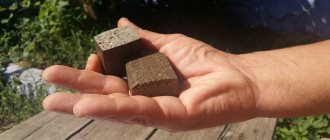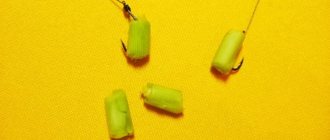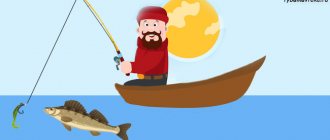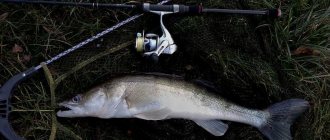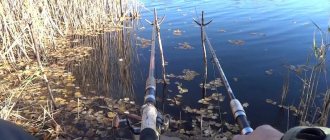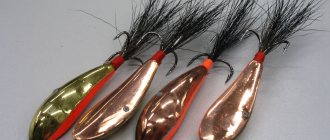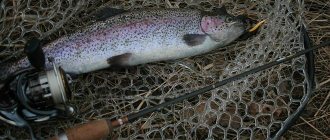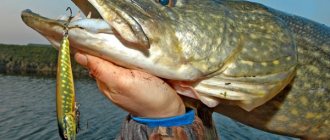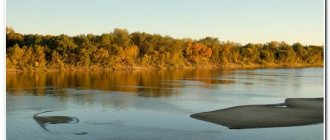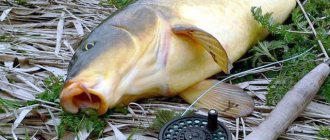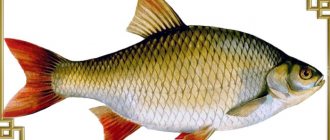Pike perch is a tasty fish, lean and almost boneless, but this is not what makes winter fishing enthusiasts go looking for it in any weather.
Neither snow nor wind can stop avid fishermen, who are ready to endure anything to get a bite from a fanged predator. Of course, after all, catching pike perch in winter promises exciting fishing, an adrenaline rush and a lot of positive emotions after the catch is on the ice. Here it is, the moment of truth! Experience, patience and diligence won. Of course, it couldn't have happened without fortune either.
Not all anglers return from such fishing with a sense of accomplishment and good mood. In order to be successful in catching pike perch in winter, you need to at least study the habits of this fish in the cold season, thoroughly know the body of water and correctly assemble your gear. Without this, the chances of catching a predator will be zero.
Where to look for pike perch in winter
Unlike the warm season, when pikeperch fishermen look for promising places with a relief bottom and snags, in winter they have to look for the fish itself. If you wait for it at one point, you can’t hope for a result. Pike perch is not some kind of roach; you can’t lure it with bait under the hole.
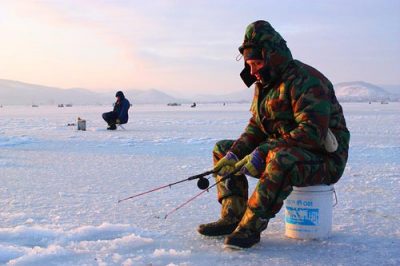
In winter, representatives of this species can be divided into two groups. The first includes individuals who have fallen into a semi-anabiotic state. Such a flock peacefully “sleeps” at the bottom of a deep hole and does not show any interest in food. Other pike perch, also gathered in schools, do not stop for a minute; they scour the pond in search of food. So you have to run after them. The good news is that active predators never change their route; they always move along the same underwater paths. If there were zander bites in a certain area, there is no doubt that after a certain time the flock will visit it again. It is these feeding places that experienced fishermen fish first.
Generally speaking, some patterns are observed in the behavior of the fished object. For example, at the very beginning of winter, he quite often goes out into shallow water to chase small fish. Later, when frosts begin to set in, pike perch moves to greater depths, where the temperature is 2-3 degrees higher than at the surface. At this time it is extremely difficult to catch. Towards the end of the winter season, it becomes active again and chases the fry. During moments of activity, you should look for it in places with various bottom anomalies (ridges, hills, sudden changes, boulders), as well as in snags and on old river beds.
Fishing for pike perch in summer
At the beginning of summer , the spawning ban ends, in each region on different days of June. And in the first half of this month, full-fledged and active fishing for pike perch opens. This period has its own peculiarity - the opportunity to catch trophy fish, since pike perch have not yet gathered in schools. The pike perch is already an individualist, but at this time he completely becomes a recluse. And if a large predator takes it, then you can hardly wait for the next pike perch bite in the same place.
effective baits at the beginning of summer , but pike perch are often better taken with wobblers. Also held in high esteem are heavy oscillating spoons, carried out in a stepwise manner, just like jigs .
often have the best catches , since they fish large areas of the reservoir, finding single large pike perch. They use fairly large wobblers for trolling with a depth of up to 6-9 meters or more, often using sinkers and bouncers to force the bait to deepen (read about trolling here).
At the height of summer, pike perch activity decreases. During the hot period of mid-summer, pike perch often refuses to bite at all on any bait during daylight hours. And only at night does it emerge onto sand spits not far from the pits. Here, sometimes light oscillating spoons and spinners of the “long” type work better, which catch more effectively if they hit the bottom when retrieving. Floating wobblers are also successfully used.
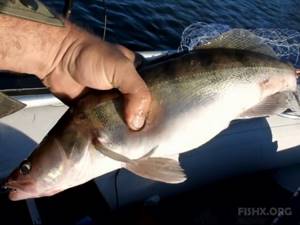
General characteristics of gear for catching pike perch from ice
Most predators offer serious resistance when fishing, and pike perch is far from the weakest among them. It fights to the last, so the tackle, regardless of the fishing method, must have a certain margin of safety. Typically it consists of:
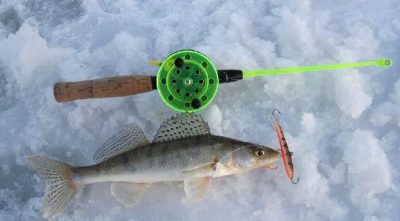
hard rod 0.4-1 m long;- a sensitive nod in the form of a spring or made of a metal plate;
- high-quality reel with easy running;
- transparent fishing line with a cross section of 0.18-0.3 mm or braided cord 0.14-0.2 mm.
Fishing in autumn
Pike perch fishing picks up again in the fall and is again active until the ice begins to form, when winter gear is used. The autumn period for fishing for pike perch is the longest during the open water season. And at this time, just like in the spring, the capture of a trophy specimen is not uncommon. This period is characterized by the fact that heavy baits and often luminous ones are used more often , since fishing occurs at great depths, often at dusk. Commonly used baits include jigs and heavy oscillating spoons. Just like for a jig with fluorescent rubber, you can use luminous elements for heavy jigs by gluing reflective strips. Oscillating lures are carried out in a stepwise manner, sometimes even shortened, where the reeling of the reel can be 1-2 turns.
I advise you to study:
Fisherman's calendar
Share with your friends!
Fishing methods and bait
Almost all existing winter fishing methods are used to catch pike perch from ice.
When fishing for this predator, a jig, a spinner, a balance beam, or a small fish as live bait can be effective.
All of the options listed have their own characteristics and nuances, without knowledge of which you cannot expect a catch. Let's try to figure out which ones exactly.
Mormyshka
Since pike perch is a fairly large fish, differing from the same perch in its impressive mouth, you need to choose a jig of the appropriate size. It could be a devil, a droplet, an ant, or an ordinary pellet up to 10 or even 15 mm long. It all depends on what kind of prey the fisherman is counting on. If you plan to catch pike perch with a jig at great depths and there is a possibility of biting trophy specimens, then it is better to use heavier baits.
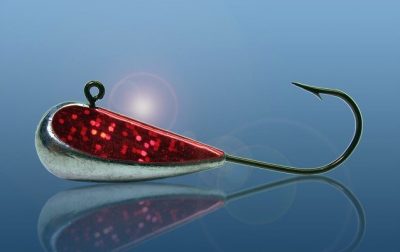
Resourceful fans of ice fishing for pike perch make their own jigs heavier by soldering tin or lead onto store-bought items. After this, they are coated with silver paint to remove the smell of molten metal. The bait is usually a bunch of bloodworms or a piece of fresh fish. If the object being fished is highly active, you can tie bright red threads onto the jig hook or attach a thin strip of rubber from an inflatable ball to it. The result will be no worse than when fishing with live larvae.
To seduce pike perch with a jig, you need to serve it smoothly, slowly swinging it in the bottom horizon. A great way to attract the attention of a predator is to tap it on the bottom, take a short pause (a few seconds) and repeat this trick again. As a result, a cloudy cloud forms above the bottom surface, which is usually raised by fry swarming in the mud. Pike perch often fall for this trick.
A technique such as dragging the bait works well, but it can only be used in the current. First, the jig must be raised above the bottom to a height of 30-40 cm, and then the line must be loosened so that the flow carries it slightly to the side. When it touches the bottom surface, you can begin to pull it to the fishing point. The bite most often occurs when it comes off the ground.
Balda
Winter fishermen call a balda a weight in the shape of a truncated cylinder suspended on a loop, on both sides of which single hooks also dangle freely. This is a classic option, but there are variations. In itself, this design is not very attractive to fish, so the forend of the hooks is wrapped with fluffy red thread or beads of any bright color are strung.
Catching pike perch at different times of the year
Pike perch is the most popular commercial fish. It has a long and thin body, a wide mouth and sharp pike-like teeth. Near the dorsal fin, the pike perch is gray-green. The belly of the fish is white or pale pink, and there are dark spots on the sides. The color of pike perch, as a rule, depends on the area where the fish lives: in the southern latitudes of Russia it is painted in dark colors, and in the northern latitudes it is painted in lighter colors.
Pike perch is the largest spiny-finned fish. Usually the maximum weight of a fish that can be caught is about 2 kg, but in large deep lakes there have also been 5-kilogram specimens, and sometimes even 10-kilogram ones! Particularly lucky fishermen managed to catch pike perch weighing more than 10 kg, but this happened extremely rarely.
Fishing for walleye varies greatly at one time or another of the year. Let's take a closer look at how to properly catch pike perch at different times of the year.
Fishing for pike perch in spring
The spring season of pike perch is characterized by a good bite when fishing on front-loaded spinners. This bait performed well in muddy, opaque water, because it is a noisy bait, and the pike perch simply does not notice it.
From mid-April to mid-May, pike perch are good on spinning rods. This is explained by the fact that it is during this period that the fish is attacked by an active zhor, so the fisherman has a high chance of catching a respectable specimen. This time of year is considered the most productive fishing period of all others. In the second ten days of May, pike perch finishes spawning, and until the end of the month it becomes difficult to catch large fish. As a rule, you can catch pike perch weighing up to 0.5 kg.
In spring, pike perch are caught rarely and very unstably. The bite can continue throughout the spring, or maybe just for a couple of days. Pike perch, like any other predatory fish, grabs the bait on the fly, so it does not have time to sink to the bottom. Due to the large amount of food available to pike perch, it usually bites the bait very rarely. However, after the water recedes, when the current carries away small fish, the pike perch will not miss the opportunity to eat and will take any bait.
In spring, pike perch can be caught both from the shore and from a boat. When choosing a place for fishing, you need to remember that the depth should not exceed 5 meters. It is better to choose a strong fishing rod, a strong fishing line (slightly longer than the rod), and a wooden float (the size of a small egg). In this case, you need to choose a sinker so that it holds the float in a vertical position. When catching pike perch from the fishing line, a hook is used to pull out the fish. Using a net is not recommended. Often, pike perch cling to the gills or belly (in the area of the pectoral fins). Long line can only be used for boat fishing or in clean areas, that is, where the chances of getting caught are minimal.
The pike perch bite in spring is quite varied. In a fast current, the float often moves sharply to the side, sometimes it sinks sharply or slowly sinks into the water, which is reminiscent of a perch bite. When fishing in such places, it is better to use dead fish as bait, supporting it with rotational movements.
Fishing for pike perch in summer
The summer period for catching pike perch begins in mid-late May and lasts until mid-August. At the same time, the fish bite better in the evening or at night. This is due to the fact that pike perch is a predatory fish and usually hunts in the dark. It loves clean water, well saturated with oxygen, so to catch it you need to choose clean rivers or flowing reservoirs. Typically, pike perch stays near slopes, dams, and flooded bridges, avoiding coastal thickets. It is more likely to catch walleye in an area with a sandy or rocky bottom rather than a silty one.
The technique for catching pike perch in summer is not much different from catching pike. For successful pike perch fishing, it is recommended to fish with narrow-shaped live bait. If you prefer to fish with a spoon, then it should also be narrow, oscillating, preferably light in color. The lure needs to be led smoothly and slowly: since the pike perch ambushes its victims, with a fast retrieve it simply will not have time to grab the bait.
When fishing for pike perch, it is also not recommended to use a metal leash, since the predator does not bite the fishing line. It is better to catch pike perch from a stable boat, because although small specimens behave passively, large specimens will strongly resist in any case. If you are planning to go fishing for pike perch, you will need to study the bottom of the reservoir in detail and choose the right echo sounder.
In addition, in the summer, pike perch are often caught using donka or mugs. The gear is installed in the evening, and the catch is checked in the morning. This type of fishing is certainly successful, but not the most passionate and interesting. Losing mugs at dusk is common, so it is not recommended to use them in excess.
Fishing for pike perch in autumn
Autumn fishing for pike perch begins in mid-August, and its peak falls at the beginning of September. In the fall, pike perch is most often taken on a jig. In early to mid-October, the predator begins to look for wintering places and gradually goes deeper, thereby reducing the effectiveness of using jigs.
With the first cold snap, the pike perch is attacked by a wild zhor, the longest of the entire year. It starts in October and ends by mid-November. It is during this period that very large specimens are found. Of course, the biting activity will be lower than in the pre-spawning period, but if the location of the pike perch is correctly determined, catching it will not be difficult.
For autumn fishing for pike perch, jig baits, heavy oscillating spoons, as well as foam rubber and polyurethane foam fish are often used. In November, it becomes more difficult to catch pike perch, but about a week before frost, large specimens are often caught.
In autumn, pike perch usually stays in the lower reaches of rivers and does not go into pits to overwinter. The fish, gathering in large schools, stay at a depth of 2-3 meters, and at the right time they move out into the river.
Fishing for pike perch in winter
This fishing season begins with the appearance of ice. Unfortunately, you can catch pike perch in winter only on “heated” rivers - those that pass through the entire city. This is explained by the fact that the river, flowing through the entire city, receives various types of waste. The water temperature rises noticeably, and the river does not freeze completely.
An acceptable bite for pike perch begins at the end of February, when the ice begins to melt and the rivers open up. In winter, pike perch is caught in the area of pits, and you can use spoons or live bait. When fishing in some places, spinners give better results than live bait.
Good luck with your pike perch hunt and trophy catches!

Some useful tips
Catching pike perch in winter will bring a lot of positive emotions, if you properly prepare for fishing, use some tips:
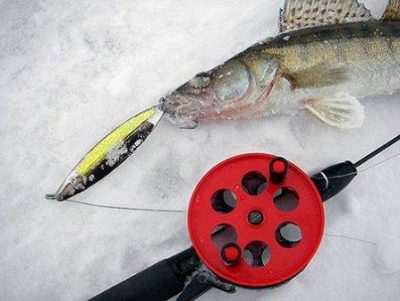
The usual winter balalaika fishing rod is not suitable for fishing for pike perch. It is too soft and short for a good hook.- You should not use long leashes, otherwise the predator will have the opportunity to spit out the bait. In addition, this reduces the sensitivity of the gear.
- Successful winter pike perch fishing largely depends on the behavior of the angler on the ice. Loud conversations with colleagues, tap dancing to warm his feet and other noise will drive him far from the hole.
- A hook, which greatly facilitates the final stage of fishing, will not interfere with such fishing.
Video on the topic:
Winter fishing for pike perch using vibes
23:00
Fishing from Mikhalych! We are looking for a predator in deep water! Labor fishing for pike perch in winter using a spinning rod
43:02
narybalke
Fishing for pike perch in spring. What you can use to catch pike perch in March, April and May
There is an opinion that catching pike perch using winter poles is rare and cannot be on a par with catching pike using ice poles. Meanwhile, during the March thaw, fishing for pike perch using winter girders can be no less successful and productive than fishing for pike. Often, even more often, the flags “light up” from the grasp of the fanged one. But there are certain features. First, the choice of live bait. Yes, the pike perch will, of course, grab a small roach, but without much enthusiasm, but wave a gentle bleak in front of its fanged face, and it will sell its fish soul to taste it... This has been verified. It’s another matter to catch bleak from the ice, and most importantly, bring it to the fishing site alive and lively. In some places, bleak can be caught well from the ice in March, in others it is caught with float rods on non-freezing rivers. And in order to deliver it to the pike perch “table” you need to keep it in a spacious container with a connected compressor for aquarium fish. On the way, you need to pump up the air with a regular enema bulb.

Secondly. The tackle needs to be lightened and made more miniature. Remove the metal leash or install the thinnest and most flexible one, because, although pike perch and pike rarely get along side by side, pike still have enough for pike perch tackle from time to time. The tee must be strong and very sharp, no larger than No. 7.5-8 of our numbering
Live bait bleak is released at the very bottom. Often in places where there are zherlits for pike perch, and these are deep places near the fairway, bershi also come out. But more often they only hit the bait, raising flags in vain. Or this situation also happens. As soon as the flag on the girder “plays” and a prickly predator gets caught on the fishing line, you can immediately lower the spoon next to it. Small pike perch approach in schools and it is quite possible that the next bite will be on bait.
April is the off-season time. It is only until the middle of the month that you can catch a predator from open water, and then there is the spawning period. But often the pre-spawning feast is so active that the impressions will last for a long time. The only problem is to get caught up in this short meal, which sometimes lasts no more than a week or even less. And to do this, sometimes you have to come to the water almost every day and check the appetite of the spring pike perch...
This period is also characterized by the fact that in the spring it is not uncommon to catch very large, so-called trophy pike perch.
At this time, it is better to catch pike perch using jig baits, and the classic ones, that is, vibrotails and twisters. Foam rubber, which is very successful in summer, is still inferior to fidgety silicone baits, although in certain conditions they also work quite successfully.
Pike perch of this period are quite suspicious of large baits. It is better to install twisters and vibrating tails no larger than 5-7 cm in size. And another feature of spring is a large number of empty pike perch outlets, when among a dozen pokes and strikers only one predator can be caught on the hook.
It takes it in places near the places of future spawning - in bays where there are deep holes, oxbow lakes and in deep channels-holes connected to the river.
Stepped wiring is used more often, but it is often combined with uniform wiring. In the spring, the pike perch is excited, it grabs the bait with a sensitive blow, and when using edible rubber, in particular, such baits as Mister Greedy, Tioga, saturated with salt and smelling of shrimp, it will repeat its furious attacks if it misses.
In the article spring fishing
you can learn how to catch other fish at this time of year.
